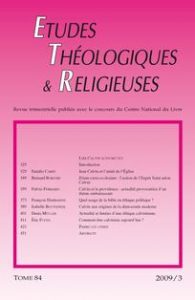Emidio Campi montre que Calvin élabore un chemin du juste milieu entre les catholiques et les anabaptistes alors que l’Église de Rome réaffirme avec force son unité institutionnelle et que les courants de la Réforme radicale pensent l’Église sur le modèle séparatiste d’une communauté de saints régénérés. Le « jugement de charité » donne un critère clair de discernement des frontières de l’Église dont il faut chercher à réaliser l’unité visible. Calvin sait que la division est pour le protestantisme la principale menace, et il se donne pour tâche d’œuvrer pour l’unité de ses deux principaux courants, les luthériens et les zwingliens. À l’occasion de la seconde dispute sur la cène, il cherche un compromis entre la consubstantiation de Luther et le symbolisme de Zwingli, et il insiste sur la communication du Christ par la médiation du Saint-Esprit. Son principal succès est alors sa déclaration conjointe avec Bullinger sur les sacrements, le Consensus Tigurinus (1549). Par-delà l’unité des Églises de la Suisse réformée avec Genève, le Consensus devait permettre de trouver un terrain d’entente avec les luthériens. Calvin ici a pourtant échoué, les luthériens jugeant cet accord contraire à l’enseignement de Luther.
In this essay, Emidio Campi shows that in the context of a resurgent Catholicism boasting about its institutional unity, and a radical sectarianism suggesting a separatist model of church consisting only of regenerate members, Calvin steered a middle course between the ecclesiological extremes of Rome and the Anabaptists. With the « judgement of charity » he set a precise standard in the quest for church unity. Calvin was concerned that disunity represented the biggest threat to the Reformation movement and concentrated himself on the task of building unity between the currents, notably the Zwinglians and the Lutherans. In the the Lord’s Supper he sought a middle way between Luther’s consubstantiation and Zwingli’s symbolism ; to that end, he insisted on what he called the spiritual eating of the body of Christ. His major achievement in this field was the joint statement on the sacraments that he produced with Heinrich Bullinger in 1549, called Consensus Tigurinus. Beyond promoting the union of the Swiss Reformed churches with Geneva, the Zurich Agreement intended to heal the breach between the Reformed and the Lutherans. Paradoxically, however, Lutheran theologians regarded the document as definitive abandonment of Luther’s teaching of the Supper in favour of Zwinglianism and vehemently opposed it.
p. 329-344
Auteur
CAMPI Emidio
Emidio CAMPI, historien suisse, est professeur émérite d’histoire de l’Église à la Faculté de théologie de l’Université de Zurich et de l’Institut pour l'histoire de la Réforme.
